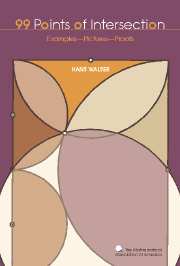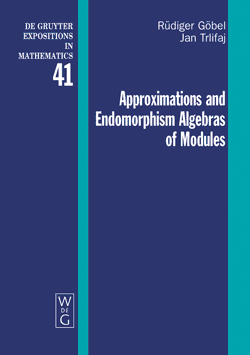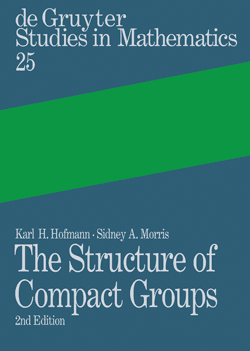Hans Walser / ETH Zentrum, Switzerland
Translated by Peter Hilton / Jean Pedersen
99 Points of Intersection
 Series: Spectrum
Series: Spectrum
Hardback (ISBN-13: 9780883855539 | ISBN-10: 0883855534)
The 99 points of intersection presented here were collected
during a year-long search for surprising concurrence of lines.
For each example we find compelling evidence for the sometimes
startling fact that in a geometric figure three straight lines,
or sometimes circles, pass through one and the same point. Of
course, we are familiar with some examples of this from basic
elementary geometry - the intersection of medians, altitudes,
angle bisectors, and perpendicular bisectors of sides of a
triangle. Here there are many more examples - some for figures
other than triangles, some where even more than three straight
lines pass through a common point. The main part of the book
presents 99 points of intersection purely visually, developed in
a sequence of figures. In addition the book contains general
thoughts on and examples of the points of intersection, as well
as some typical methods of proving their existence.
* Translated from the original German
* Readily accessible to students at the undergraduate level but
will appeal to anyone interested in geometry
* The examples given have both geometrical interest and an
intriguing aesthetic aspect
Contents
Part I. What's It All About?: 1. If three lines meet; 2. Flowers
for Fourier; 3. Chebyshev and the Spirits; 4. Sheaves generate
curves; Part II. The 99 points of intersection: Part III. The
Background: 1. The four classical points of intersection; 2.
Proof strategies; 3. Central projection; 4. Cevafs Theorem; 5.
Jacobifs Theorem; 6. Remarks on selected points of
intersection; References.
Gobel, Rudiger / Trlifaj, Jan
Approximations and Endomorphism Algebras of Modules
 24 x 17 cm. Approx. 624 pages. Cloth. ISBN 3-11-011079-2
24 x 17 cm. Approx. 624 pages. Cloth. ISBN 3-11-011079-2
Series: de Gruyter Expositions in Mathematics 41
Subjects: Mathematics / Algebra, Number theory
Language: English
to be published July 2006
This monograph provides a thorough treatment of two important
parts of contemporary module theory:
Approximations of modules and their applications, notably to
infinite dimensional tilting theory, and
Realizations of algebras as endomorphism algebras of groups and
modules. Attention is also given to E-rings and free modules with
distinguished submodules.
The monograph starts from basic facts and gradually develops the
theory to its present frontiers. It is suitable for graduate
students interested in algebra as well as experts in module and
representation theory.
Hofmann, Karl H. / Morris, Sidney A.
The Structure of Compact Groups, 2nd. rev. ed.
A Primer for Students - A Handbook for the Expert
 24 x 17 cm. Approx. 886 pages. Cloth.
24 x 17 cm. Approx. 886 pages. Cloth.
ISBN 3-11-019006-0
Series: de Gruyter Studies in Mathematics 25
Subjects: Mathematics / Algebra, Number theory
Mathematics / Geometry and Topology
Language: English
Dealing with the subject matter of compact groups that is
frequently cited in fields like algebra, topology, functional
analysis, and theoretical physics, this book has been conceived
with the dual purpose of providing a text book for upper level
graduate courses or seminars, and of serving as a source book for
research specialists who need to apply the structure and
representation theory of compact groups.
The first edition of 1998 was well received by reviewers and has
been frequently quoted in the areas of instruction and research.
For the present new edition the text has been improved in various
sections. New material has been added in order to reflect ongoing
research.
Joseph C. Varilly (Universidad de Costa Rica):
An Introduction to Noncommutative Geometry
EMS Series of Lectures in Mathematics
ISBN 978-3-03719-024-1
June 2006, 121 pages, softcover, 17.0 cm x 24.0 cm.
Noncommutative geometry, inspired by quantum physics, describes
singular spaces by their noncommutative coordinate algebras, and
metric structures by Dirac-like operators. Such metric geometries
are described mathematically by Connes' theory of spectral
triples. These lectures, delivered at an EMS Summer School on
noncommutative geometry and its applications, provide an overview
of spectral triples based on examples.
This introduction is aimed at graduate students of both
mathematics and theoretical physics. It deals with Dirac
operators on spin manifolds, noncommutative tori, Moyal
quantization and tangent groupoids, action functionals, and
isospectral deformations. The structural framework is the concept
of a noncommutative spin geometry; the condiditons on spectral
triples which determine this concept are developed in detail. The
emphasis throughout is on gaining understanding by computing the
details of specific examples.
The book provides a middle ground between a comprehensive text
and a narrowly focused research monograph. It is intended for
self-study, enabling the reader to gain access to the essentials
of noncommutative geometry. New features since the original
course are an expanded bibliography and a survey of more recent
examples and applications of spectral triples.
Contents
S. Akbulut, T. Onder, and R.J. Stern (editors)
Proceedings of Gokova Geometry-Topology Conference 2005
ISBN-10: 1-57146-152-3
ISBN-13: 978-1-57146-152-0
Year Published: 2006
Pages: 212 pages
Binding: Hardcover
Description:
Dedicated to the memory of Raoul Bott, a great mathematician of
the 20th Century, this proceedings volume contains articles from
both eleventh and twelfth Gokova Conferences, held in Gokova,
Turkey.
Contents:
Seven short stories on blowups and resolutions, H. HAUSER
Real algebraic structures, S. AKBULUT
Lefschetz decomposition and the cd-index of fans, K. KARU
Some remarks on G2-structures, R. L. BRYANT
The exceptional holonomy groups and calibrated geometry, D. JOYCE
Ricci-flat deformations of asymptotically cylindrical Calabi?Yau
manifolds, A. KOVALEV
Deformations of Special Lagrangian submanifolds: an approach via
Fredholm alternative, S. SALUR
Plane curves and contact geometry, L. NG
An open book decomposition compatible with rational contact
surgery, B. OZBAGCI
Virtual links and orientations of chord diagrams, O. VIRO
 Series: Spectrum
Series: Spectrum 24 x 17 cm. Approx. 624 pages. Cloth. ISBN 3-11-011079-2
24 x 17 cm. Approx. 624 pages. Cloth. ISBN 3-11-011079-2  24 x 17 cm. Approx. 886 pages. Cloth.
24 x 17 cm. Approx. 886 pages. Cloth.